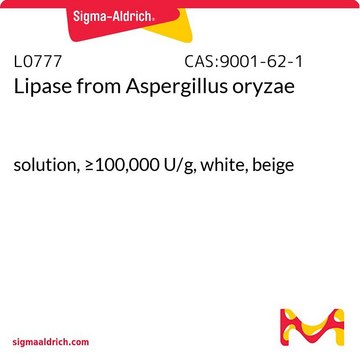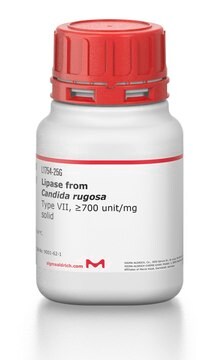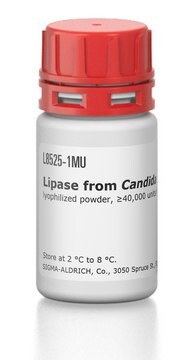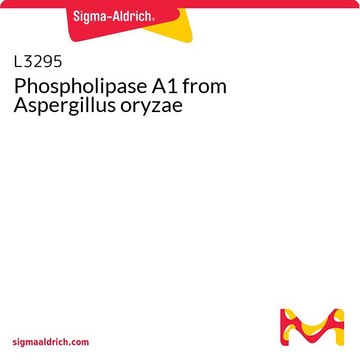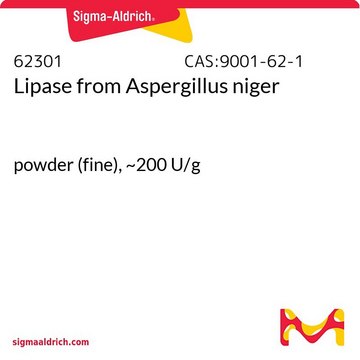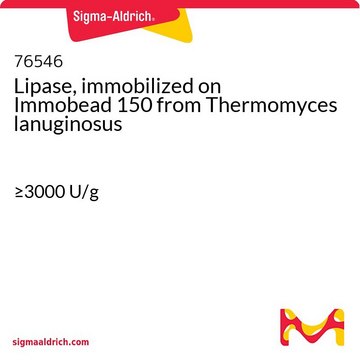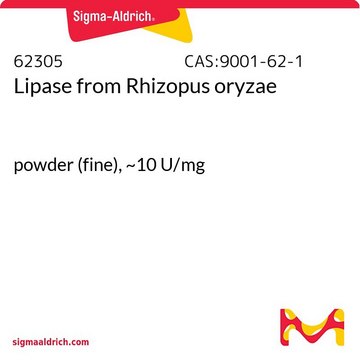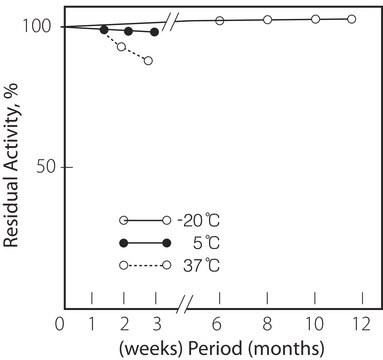L4277
Lipase from Aspergillus oryzae
≥20,000 U/g
Sinonimo/i:
Palatase® 20,000L
Autenticatiper visualizzare i prezzi riservati alla tua organizzazione & contrattuali
About This Item
Prodotti consigliati
Stato
lyophilized
Livello qualitativo
Attività specifica
≥20,000 U/g
Temperatura di conservazione
2-8°C
InChI
1S/C11H9N3O2.Na/c15-8-4-5-9(10(16)7-8)13-14-11-3-1-2-6-12-11;/h1-7,16H,(H,12,14);/q;+1/b13-9-;
QWZUIMCIEOCSJF-CHHCPSLASA-N
Descrizione generale
Lipase from Aspergillus Oryzae is a carboxylesterase and belongs to the α/β-hydrolase family. It comprises a lid domain, hinge domain and a catalytic triad Ser?His?Asp/Glu. The three-dimensional structure is a α/β hydrolase fold which is very similar as that of esterase enzyme.
Applicazioni
Lipase from Aspergillus Oryzae has been used:
- in the partial digestion of triacylglycerols (TAG)
- in the digestion of (12-ricinoleoylricinoleoyl)diricinoleoylglycerol (RRRR) present in castor oil
- in the hydrolysis of linseed oil
Azioni biochim/fisiol
Lipase catalyzes the hydrolysis of monoacylglycerols and diacylglycerols and its activity is inhibited by divalent actions. Aspergillus Oryzae lipase is an industrial enzyme with application in food, detergent and pharmaceutical industries. It is also used in immobilization studies for 1,3-dioleoyl-2-palmitoylglycerol (OPO) synthesis. Aspergillus Oryzae lipase may have potential in producing biodiesel from waste cooking oil.
Nota sulla preparazione
purified 1,3-specific lipase from Aspergillus Oryzae produced by submerged fermentation of a genetically modified Aspergillus Oryzae microorganism
Note legali
A product of Novozyme corp.
Palatase is a registered trademark of Novozymes Corp.
Avvertenze
Danger
Indicazioni di pericolo
Consigli di prudenza
Classi di pericolo
Resp. Sens. 1
Codice della classe di stoccaggio
11 - Combustible Solids
Classe di pericolosità dell'acqua (WGK)
WGK 1
Punto d’infiammabilità (°F)
Not applicable
Punto d’infiammabilità (°C)
Not applicable
Dispositivi di protezione individuale
Eyeshields, Gloves, type N95 (US)
Scegli una delle versioni più recenti:
Possiedi già questo prodotto?
I documenti relativi ai prodotti acquistati recentemente sono disponibili nell’Archivio dei documenti.
I clienti hanno visto anche
Jiann-Tsyh Lin et al.
Journal of agricultural and food chemistry, 56(10), 3616-3622 (2008-04-30)
(12-Ricinoleoylricinoleoyl)diricinoleoylglycerol (RRRR), a tetraacylglycerol, was identified earlier in castor oil. Using ESI-MS (4), 95% of the 12-ricinoleoylricinoleoyl chain was identified at the sn-2 position of the glycerol backbone of RRRR. Regiospecific location of the 12-ricinoleoylricinoleoyl chain of RRRR on the
Xianming Zhao et al.
Frontiers in microbiology, 10, 645-645 (2019-04-12)
Thraustochytrium is a marine protist that can accumulate a large amount of very long chain polyunsaturated fatty acids (VLCPUFA) in triacylglycerols (TAG). How these freshly synthesized VLCPUFAs are channeled into TAG remains unknown. In this study, the glycerolipid profile of
Thais de Andrade Silva et al.
Scientific reports, 12(1), 6815-6815 (2022-04-28)
The use of enzymes immobilized on nanomagnetic supports has produced surprising results in catalysis, mainly due to the increase in surface area and the potential for recovery and reuse. However, the meticulous control of the process and difficulties in reproducibility
Preliminary Investigation: Stearidonic Acid Production by Genetically Modified Saccharomyces cerreviseae Using Linseed Oil as A Fatty Acid Source
Muzakhar K
Jurnal Ilmu Dasar, 9(1), 8-Jan-8-Jan (2008)
Andre Mong Jie Ng et al.
International journal of molecular sciences, 22(19) (2021-10-14)
Medium-chain triglycerides (MCTs) are an emerging choice to treat neurodegenerative disorders such as Alzheimer's disease. They are triesters of glycerol and three medium-chain fatty acids, such as capric (C8) and caprylic (C10) acids. The availability of C8-C10 methyl esters (C8-C10
Il team dei nostri ricercatori vanta grande esperienza in tutte le aree della ricerca quali Life Science, scienza dei materiali, sintesi chimica, cromatografia, discipline analitiche, ecc..
Contatta l'Assistenza Tecnica.